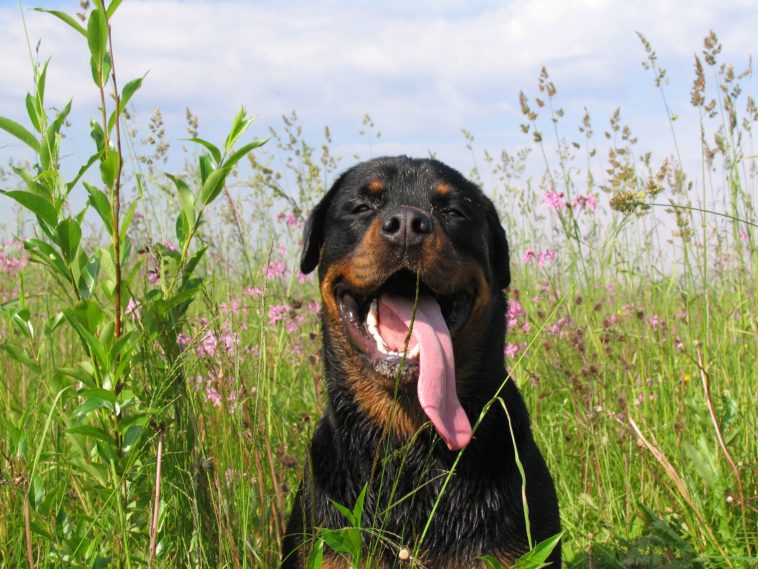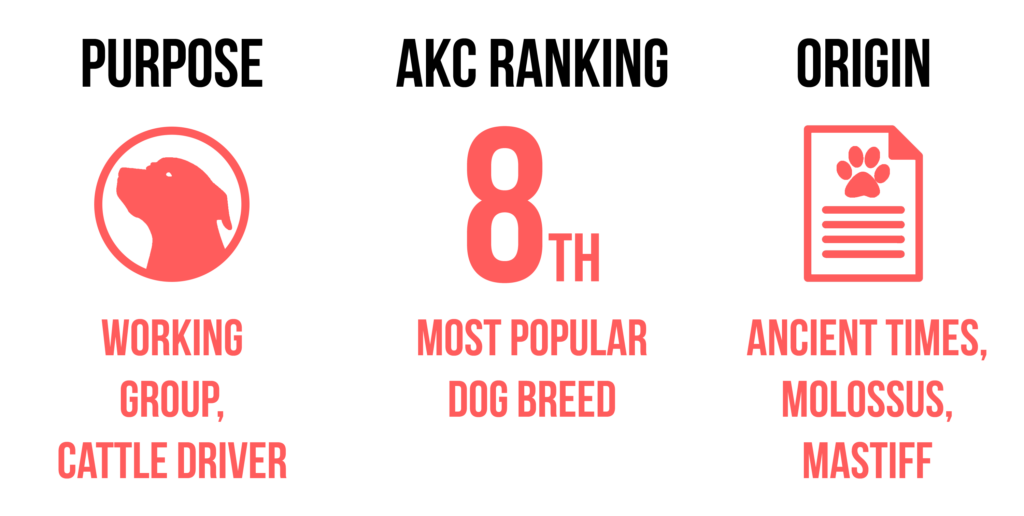
Rottweilers are relatively large dogs – and with good reason. Rottweilers are one of the working dog breeds, and their original purpose was to drive cattle to the market. As time went on, Rottweilers were used for other working needs, such as pulling carts for butchers and serving as some of the earliest police dogs, as well as serving in the military. Today, Rottweilers are mostly notable for being great family dogs and guardians.
Did You Know?
- Due to his size, many people might have misconceptions about the Rottweiler. Be prepared to receive erroneous judgments about your pet even if you train and socialize him.
- Rottweilers are very sensitive and do not like spending time apart from their families. Make sure your Rottweiler has company and exercises often, otherwise they may act out by destroying objects around them.
- A rottweiler dog must be socialized from an early age if you want it to get along with other animals. Adult Rottweilers can be very aggressive towards strange dogs (especially if they’re the same sex) if they haven’t been taught to be friendly with other pets from puppyhood. If you still want to introduce your adult Rottweiler to other dogs, make sure you do so carefully and show off your strong leadership skills in order to create a peaceful coexistence between the animals.
- Be a confident firm owner if you plan on getting a Rottweiler. If you’re not specific in your demands, your Rottweiler may exploit any loopholes they see. Because of their intelligence, Rottweilers will test you to see if you mean what you say.
- Rottweilers have a double coat that sheds moderately throughout the year, except during spring and fall, when they shed heavily.
- Make sure you monitor your Rottweilers’ eating habits, otherwise they can overeat and gain weight.
- Because of their large, powerful physiques, Rottweilers need to be trained and socialized extensively from an early age.
- Check your local ordinances for any restrictions against Rottweilers. Due to a current prejudice against dogs like the Rottweiler and the misconception that they are dangerous, some areas may have special rules regarding the breed. Depending on where you live, you may have to carry extra liability insurance if you own a Rottweiler or may even be banned from owning one altogether.
- Rottweilers will naturally want to herd children and may even “bump” them, which can cause injuries if they fall down and hurt themselves in the process. However, if they are raised alongside children and trained well, Rottweilers can get along just fine with kids. However, make sure you always keep an eye on children when they’re playing with or around your Rottweiler.
- Rottweilers are highly-trainable dogs and very intelligent. Make sure you are firm and consistent and you will have a very obedient pet.
- Rottweilers are energetic, but not as energetic as other dogs. However, be prepared to walk or play with them for an average of 10 to 20 minutes a day.
- If you’re a light sleeper, it’s probably not a good idea to have your Rottweiler sleep with you, as they tend to snore.
Breed Characteristics
Adaptability

Adapts Well to Apartment Living: 2.5/5
Good for Novice Owners: 1/5
Tolerates Being Alone: 0.5/5
All-Around Friendliness

Affectionate with Family: 5/5
Dog-Friendly: 1.5/5
Friendly Toward Strangers: 4.5/5
Health Grooming

Amount of Shedding: 4.5/5
Easy to Groom: 5/5
General Health: 2.5/5
Trainability

Easy to Train: 4/5
Intelligence: 5/5
Tendency to Bark or Howl: 4.5/5
Exercise Needs

Energy Level: 4/5
Intensity: 4.5/5
Potential for Playfulness: 5/5
Overview
Rottweilers are strong dogs with a heart full of love. Originally from Germany, Rotts or Rotties (as they are affectionately called) were primarily used to pull carts for butchers and farmers and to drive cattle; their muscle body and broad chest is a reflection of that work. Rotts display large amounts of stamina and strength when on the go and an intelligent, fearless expression in their eyes. When well-trained, Rotties can be confident and calm. They are usually aloof in the presence of strangers but are never afraid or timid.
Due to their “wait-and-see” attitude when faced with new experiences and people, Rottweilers make natural guard dogs. Because of their mellow disposition and their skeptical attitude, Rottweilers also make great family friends as well as police and military dogs. Rottweilers form strong bonds with their human family and will become fierce in their defense if they come under threat. Rottweilers must be socialized and trained from an early age, usually given a regular job to perform, otherwise they’re at risk of becoming bullies instead of good companions.
Rotts can become overly protective and aggressive if not taught to be calm and well-tempered. If badly trained, Rottweilers will lack the ability to discriminate friend from foe, which is why it’s important you provide him with leadership that he can trust without resorting to physical force or anger. If you don’t, your Rottweiler will assume the role of top dog, and with a dog as powerful as a Rottweiler, this can be bad news. However, Rotties are not naturally vicious. On the contrary: if they are well-bred and trained socially, Rotties can be gentle, loving, and playful companions to their families.
If treated with respect, Rottweilers can be easily trained. However, they are not for everyone. If you’re planning on adopting a Rottweiler, you must not only be prepared to train him adequately but also be ready to deal with outside judgment and city ordinances. Due to bad experiences with either Rottweilers or large dog breeds in general, certain cities have implemented restrictions on Rottweiler ownership. Some cities have gone as far as to ban them outright.
Make sure you train your Rottie well so that you can dispel any misconceptions that are out there. Don’t leave your Rottweiler outside to fend for himself. Rotties are sensitive dogs and want to be with their families. If you train him well, you will have one of the greatest companions in the world by your side.

History
Rottweilers are descendants of the Molossus, an extinct mastiff-type dog. Molossus dogs marched with the Romans all the way to Germany, driving the Romans’ cattle as the journeyed and conquered the world. Molossus dogs mated with many different dogs as they traveled, laying the foundations for new breeds to be born.
Along their march, the Romans decided to set up colonies in the southern region of Germany due to its climate and soil. One of the distinct features of the colony were the villas that were roofed with red tile. After 600 years, inhabitants of the area excavated parts of the town and found one of these red-tiled villas. Due to the tile coloring and the new discovery, the town was renamed “das Rote Wil,” which translates to “the red tile.” Descendants of the Molossus dogs in the area were thus called Rottweilers.
The area had a growth in their cattle market and Rottweilers were the ones driving the cattle to the town for butchering. After selling their livestock, cattlemen would put their money in a purse and hang it around their Rottweiler’s neck to keep it safe from thieves. For some time, butchers used Rottweilers to pull meat-loaded carts around, but rail transport eventually replaced these cattle drives. Due to this new technology, Rottweilers went unused and almost extinct.
In 1901, the first Rottweiler breed standard was written by the Rottweiler and Leonberger Club. Since that time, the Rottweiler’s character and appearance have changed slightly. Police started using them as part of their K-9 unit. Over the years, several Rottweiler-focused clubs were created, but none with as much staying power as the Allgemeiner Deutscher Rottweiler Klub (ADRK). Founded in 1921, the ADRK is dedicated to preserving the Rottweiler’s working ability as well as promoting good breeding programs throughout the world.
The first Rottweiler to make it across the sea to the U.S. is thought to have come along with a German immigrant sometime in the 1920’s. The American Kennel Club (AKC) had its first Rottweiler registration in 1931 with a dog named Stina v Felsenmeer. The Rottweiler became popular as an excellent obedience dog after World War II.
The Rottweiler’s popularity reached its highest peak in the mid-1990’s as more than 100,000 Rotties were registered with the AKC. However, popularity is not all that great, as it can lead to puppy mills and irresponsible breeders to put profit over the dog’s health and proper breeding. Unfortunately, this was the case with the Rottweilers.
Eventually, the Rottweiler suffered from bad publicity and the demand decreased. During this downtime, responsible breeders have taken it upon themselves to make sure the breed is healthy and well-tempered. Currently, Rottweilers are the 8th most popular dog breed according to the AKC.
Size
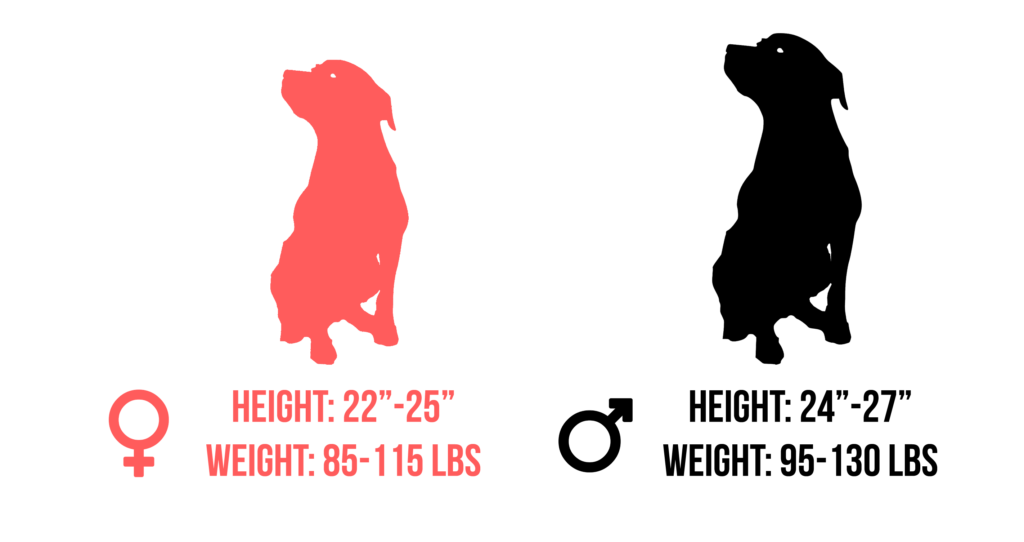 Male Rottweilers usually weigh between 95 to 130 pounds while females weigh between 85 to 115 pounds. Males general stand between 24 to 27 inches tall at the shoulder and females stand between 22 to 25 inches tall at the shoulder.
Male Rottweilers usually weigh between 95 to 130 pounds while females weigh between 85 to 115 pounds. Males general stand between 24 to 27 inches tall at the shoulder and females stand between 22 to 25 inches tall at the shoulder.
Appearance
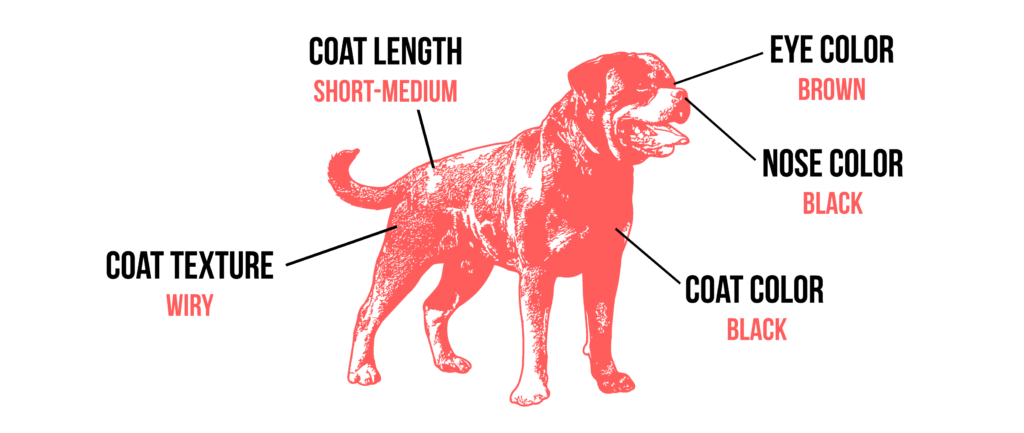 Rotties have a coarse and straight, short double coat. Their undercoat is mainly located on their necks and thighs, while their outer coat is medium in length and shorter around the legs, ears, and head. Depending on your local climate, your Rottie will have more or less undercoat. Their coating is always black and they have markings that range from mahogany to rust in color. These markings are visible on the chest and legs, on the cheeks and each side of the muzzle, beneath the tail and over the eyes. Their toes also have pencil mark-like tan lines.
Rotties have a coarse and straight, short double coat. Their undercoat is mainly located on their necks and thighs, while their outer coat is medium in length and shorter around the legs, ears, and head. Depending on your local climate, your Rottie will have more or less undercoat. Their coating is always black and they have markings that range from mahogany to rust in color. These markings are visible on the chest and legs, on the cheeks and each side of the muzzle, beneath the tail and over the eyes. Their toes also have pencil mark-like tan lines.
Behavior
Personality
Rottweilers are usually very confident and courageous. They have a “wait-and-see” attitude that prevents them from being too friendly with new people immediately after meeting them. They are not easily excitable. Rottweilers are very affectionate when it comes to their families, often following them around the house. They are very protective of their family and property, but will never be aggressive towards people unless there is a good reason to be (such as if the family comes under threat).
Rottweilers are intelligent dogs and have a strong work ethic. Both male and female Rottweilers can be stubborn but are also highly trainable. However, they also have differences. Male Rotts, for example, are usually quiet and watchful, often assessing their environment for possible threats. Females, on the other hand, can be more affectionate and easier to control. Rottweilers are not for everyone.
If you plan on getting one, you should be ready to be an assertive owner, otherwise, they will walk all over you. They need a firm, consistent discipline but not harsh. Establish your leadership role and your Rottweiler will listen to you, otherwise, they may bully or bluff you. Spend time training them and supervising them daily. You can earn your Rottweilers respect by setting boundaries and teaching them the consequences for misconduct, just make sure you’re not too harsh.
Unlike some people may think, Rottweilers are not naturally aggressive. Their temperament is decided by various factors, such as socialization, heredity, and training. Rottweiler puppies are usually playful and curious, willing to be held by people if they have nice temperaments. If you want to have a good idea of what your Rottweiler puppy’s temperament will be like when they grow up, meet one of the parents and that way you can be sure that they come from dogs with nice temperaments. If you don’t have access to the parents, see if you can meet your dog’s siblings or other relatives.
Exposing your Rottweiler to various experiences and people from an early age will help their social skills greatly. Activities you can do to improve their socialization include taking him to busy parks, enrolling him in puppy kindergarten, and introducing him to neighbors while taking him on walks.
Children and Other Pets
Rottweilers are known to get along with kids, especially if they grow up with them. Due to their size, it’s a good idea to supervise any interaction your children have with your Rottweiler. Rottweilers may rely on their cattle-driving instincts and nudge your kids, accidentally knocking them down. When your children have friends over, they may make loud noises or play roughly, which could lead the Rottweiler to believe the kids are in danger. Rottweilers may also chase running children. The importance of supervision around small children cannot be emphasized enough, as well as training him so that he’s aware which behaviors are permissible and which are not.
Rottweilers generally get along well with other animals that are raised side by side with them. However, they may not like being introduced to a new animal all of a sudden, especially if they’re the same sex. If you train and guide them appropriately, they should listen to you and make a peaceful transition into a home with more pets. Always keep your Rottweiler on a leash in public and avoid dog parks where off-leash dogs are common.
Health
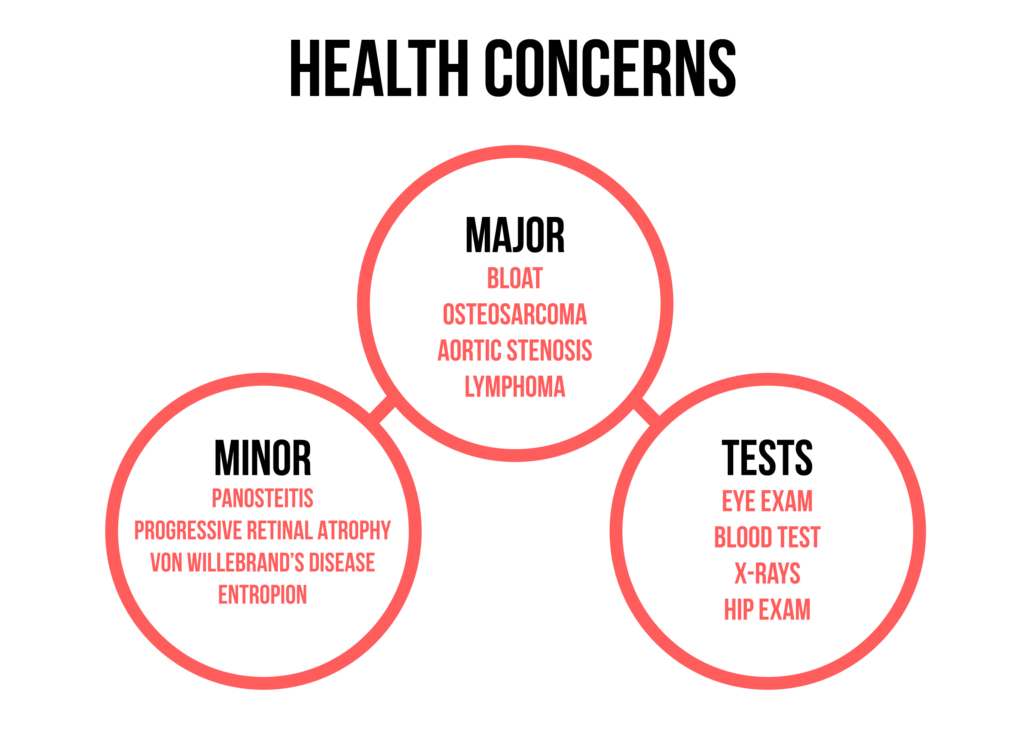 Rottweilers tend to be a healthy breed. Unfortunately, like all dogs, there are certain conditions that affect them more than other dogs. While your Rottie may not suffer from any of these conditions during their lifetime, it’s a good idea to be aware of the following conditions just in case your dog comes down with one of them.
Rottweilers tend to be a healthy breed. Unfortunately, like all dogs, there are certain conditions that affect them more than other dogs. While your Rottie may not suffer from any of these conditions during their lifetime, it’s a good idea to be aware of the following conditions just in case your dog comes down with one of them.
Allergies
Dogs, in general, can suffer from a variety of allergies. If your Rottie suffers from food allergies, treat it by trial and error until you discover which food causes the allergies. If they suffer from contact allergies, such as from flea powder, dog shampoos, or bedding, remove the cause of the allergy.
If your Rottie suffers from inhalant allergies, like when they breathe in dust, mildew, or pollen, make sure they receive the proper allergy medication based on the severity of the allergy. If your Rottie suffers from ear infections, that may be a sign of inhalant allergies.
Osteosarcoma
One of the more serious (and deadly) conditions your Rottweiler may suffer from is osteosarcoma, which is an aggressive type of bone cancer. Usually affecting large breeds, osteosarcoma can be diagnosed through x-rays. If your dog is suffering from lameness, it could be a sign that they’re suffering from this disease, so it’s a good idea to get the vet to check them. Chemotherapy and amputation of the affected limb is usually the norm. After treatment, a dog can live between nine months to two years. Dogs don’t have the same side effects from chemotherapy as humans do and they usually adapt well to moving with three limbs.
Hypothyroidism
When suffering from this condition, your Rottweiler’s thyroid gland will produce abnormally low levels of hormones. Due to this dysfunction, your Rottweiler can gain weight, have poor coating, and suffer from reproductive problems among other issues. Your Rottweiler’s skin can also become dark and tough, while their fur will become coarse and brittle and even fall out.
This condition usually happens in middle-aged dogs. Other symptoms of the condition include mental dullness, drooping eyelids, irregular heat cycles, lethargy, and overall low levels of energy. Luckily, the condition can be treated with medication. The medication must be administered on a daily basis for the rest of your dog’s life and, if properly managed, your Rottweiler can continue to lead a long and healthy life.
Aortic Stenosis/Subaortic Stenosis (AS/SAS)
Aortic stenosis is a common heart defect that sometimes affects Rottweilers. The heart works harder than usual to supply blood to the body due to a narrowing of the aorta below the aortic valve. If your Rottweiler suffers from this, they may faint or even suffer from sudden death. At the moment, it’s unknown how the disease is transmitted, but we know that it’s an inherited condition. If your vet detects a heart murmur, they can perform further tests to diagnose the condition.
Panosteitis (Pano)
Known as “growing pains,” panosteitis generally happens when puppies hit the four-month benchmark. Lameness is the primary symptom, which can be treated with something as simple as resting. However, take your Rottweiler puppy to the vet for a checkup if it starts limping.
Elbow Dysplasia
Elbow dysplasia is a heritable malformation which might affect your Rottweiler in their elbow joint, which is particularly common among large-breed dogs. A dog’s elbow is made up of three bones, and different growth rates of these bones may cause joint laxity and elbow dysplasia. Depending on the situation, your vet might either recommend surgery or simply medication to control the pain, as this condition can lead to painful lameness.
Gastric Dilatation-volvulus (GDV), also called Bloat or Torsion
One of the more serious conditions your Rottweiler can suffer from is gastric dilatation-volvulus (GDV), or “bloat.” This condition particularly affects large, deep-chested dogs like your Rott and is life-threatening, so it should be taken seriously. When a dog suffers from bloat, their stomach becomes distended with air or gas and then twists, making it impossible for the dog to belch or vomit to rid itself of any excess air or gas. Blood is impeded from returning normally to the heart, blood pressure drops and the dog goes into shock.
In such condition, immediate medical attention is needed to prevent your dog from dying. Bloat may occur if your dog is fed one large meal a day, eats rapidly, drinks large amounts of water after eating, and exercises strenuously after eating. Keep an eye on your dog if you notice they are salivating excessively and are trying to vomit but can’t. Other signs may include restlessness, depression, lethargy, and weakness with a rapid heart rate. If you notice your Rott suffers from any of these symptoms, consult a veterinarian immediately.
Hip Dysplasia
Hip Dysplasia is another heritable condition passed down from parent to pup where the dog’s femur doesn’t perfectly fit into the pelvic socket of the hip joint, which can cause pain and lameness on one or both rear legs. However, keep in mind that the condition can exist without clinical signs, which is why it’s important to screen your Rottweiler and have them X-rayed to make sure they don’t suffer from hip dysplasia. Dogs with hip dysplasia can also develop arthritis as they age.
Maintenance

Care
Rottweilers are sensitive dogs that don’t like to be left alone. They’re not particularly outside dogs either, so it’s probably best to have them live inside the home. When left outside and alone for long periods of time, Rottweilers will become bored and may act out aggressively by destroying property. When they’re indoors, they are usually inactive and you don’t have to worry about them running around destroying your things.
A fenced yard is essential to both protect him from running into traffic as well as keeping him in when strangers or other dogs come into the property. Make sure the fence is strong and big, as an underground electronic fence can’t keep your Rottie contained if he wants to get out. Underground electronic fences will also not keep other people or dogs from coming into your yard, which can cause a problem if your Rottweiler feels threatened.
Energy levels amongst Rotts range from lazy to very active. If your Rott is just moderately active, taking him on 20-minute walks should work for him. Hiking and playing catch are also things that Rotts enjoy. If your Rottie is the highly-active type, you may have to spend more time with him exercising and playing with him. Rottweilers are perfectly suited for agility or obedience competitions due to their intelligence, trainability, and athleticism. Therapy work, tracking, and pulling carts are also things Rottweilers are good at.
Due to their intelligence, Rottweilers need mental stimulation and may even wait for you to show them why they should do something before doing it. They are generally eager to please you and learn new things. House training your Rottweiler should not be difficult if you are a firm, fair, and consistent owner. Make sure he receives positive reinforcement and a consistent schedule and you will have a great companion by your side.
Feeding
The amount and timing of feeding your dog depend on your individual pet. However, for Rottweilers, the recommended amount of food they should consume daily is about four to ten cups of high-quality dry food, two times a day.
Rottweilers run the risk of becoming overweight, so it’s a good idea to avoid this by measuring their food intake instead of leaving it out there for him to eat whenever he wants. To check if your Rottie is overweight, look down at him to see if you can detect his waist. If you can see it from where you’re standing, then place your hands on his back, fingers spread downward and thumbs lined up along the spine. If you press lightly and can’t feel his ribs, it means he needs to eat less and exercise more.
Grooming
For the most part, Rottweilers are average shedders and need to be brushed about once a week with a firm bristle brush in order to distribute his skin oils and remove any dead hair hanging on. During springtime and fall, he will shed more than usual and you will need to brush him more than once a week. Bathing should be done on an “as needed” basis. Outdoor bathing should be done in warm weather. If you feel the need to wear a coat or a long-sleeved, it’s too cold and you should bathe him indoors.
It’s a good idea to brush your Rott’s teeth about two to three times a week if you want to remove any bacteria lurking inside his mouth or any tartar that has built up. If you want to prevent bad breath and gum disease, brushing his teeth daily is even better. If he’s an adult and has hardly seen a toothbrush in his life, it might be hard to get the job done. That’s why it’s important to train him from puppyhood that it’s ok for you to brush his teeth or for a vet to examine him. If you handle his paws frequently and make grooming a positive experience, he will look forward to it as a grown-up instead of causing problems.
Questions
How long do Rottweilers live?
Rottweilers have an avergae lifespan of 8 to 11 years.
Is a Rottweiler a good family dog?
Rottweilers are great family dogs. They get along with kids, especially if they are raised side by side. However, keep in mind that the Rottweiler’s original purpose was the herd cattle, so he may try to herd your kids by nudging them and pushing them. As long as you teach your Rottie not to do this, you should be fine.
Is a Rottweiler capable of being a great first dog?
Of course. As long as you are a firm and consistent owner and are able/willing to spend time training him, a Rottweiler can be a great first dog. However, because raising a Rottweiler can take a lot of work, it’s recommended that you gain more experience as a dog owner first before adopting a Rottweiler unless you want your hands full.
Resources
Rescue Groups
Before you can adopt a Rottweiler, make sure you do your research and are sure that they are a good fit for you. There are a number of Rottweilers in need of adoption. The following list only covers a few of the rescue groups out there. Contact the national breed club if you don’t see a rescue group listed for your area.
- Rottie Empire Rescue
- Nova Rottweiler Rescue League, Inc.
- For The Love of Dog
- Atlantic Rottweiler Rescue Foundation
- Ohio Rottweiler Rescue
- Southern States Rescued Rottweilers
- Gulfstream Guardian Angels Rottweiler Rescue
- Mid America Rottweiler Rescue
- Big Sky Rottweiler Rescue
- Rottweiler Rescue of Los Angeles, Inc
Breed Organizations
Click on any of the links below to find additional information about the Rottweiler from these breed clubs, associations, and organizations.
- American Rottweiler Club
- United States Rottweiler Club
- Rottweiler Klub of North America
- Colonial Rottweiler Club
Top Breeders
The following is a list of the most reputable Rottweiler breeders of 2017.
- Twin Creeks Rottweilers (Vashon, Washington)
- Silverhill Rottweilers (Kenly, North Carolina)
- Rottweiler kennel Lucene Kennels (Alpine, California)
- 2Infinity Rottweilers LLC (Dallas, Oregon)
- Hidden Oaks Working Farm (Oviedo, Florida)
- Von Evman Rottweilers (Groveland, Florida)
- Dreibergen Rottweilers (Battle Ground, Washington)
- King Rottweilers (Spokane, Washington)
- Ostenberg Rottweilers (Snohomish, Washington)
- Bolles Rottweilers (Warrensburg, Missouri)
Rottweiler Adults For Sale
If you’re interested in purchasing adult Rottweilers, click on the links below to find what you’re looking for.
Rottweiler Puppies For Sale
If you’re interested in purchasing Rottweiler puppies, below you will find different online marketplaces that have Rottweiler puppies for sale.
